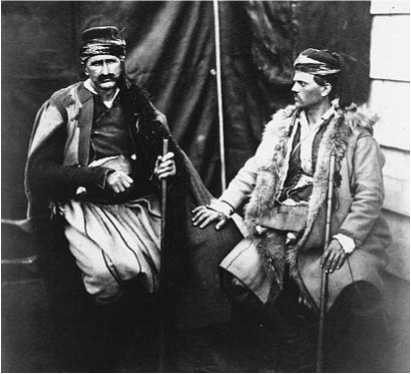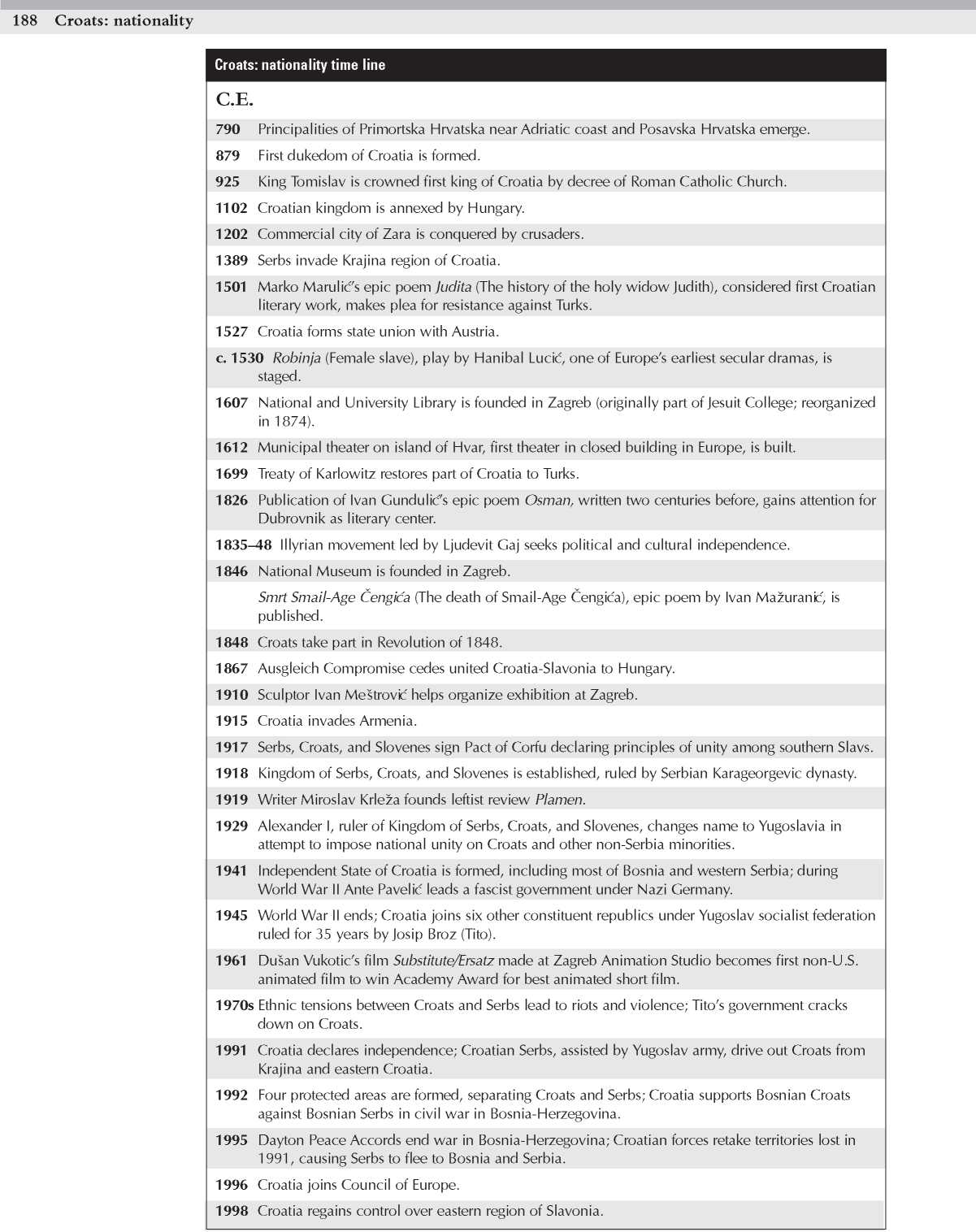GEOGRAPHY
Croatia is bounded in the northeast by Hungary, and in the northwest by Slovenia. Bosnia and Herzegovina lie to the east and south, Serbia and Montenegro lie to the east. The Adriatic Sea defines the nation’s western limits. Croatia’s area is 21,829 square miles.
The fertile Pannonian and para-Pannonian plains of the north and northeast are lush agricultural regions. The Sava and Drava, two principal rivers, provide water for the plains and eventually drain into the Danube River in the east. Zagorje Hills, a valley north of Zagreb, separates the two rivers. The Dinaric Alps lie in the south and west of Croatia, where the country’s highest peak, Mount Troglav (6,276 feet), is found. The Karst, a limestone plateau, is also found in this region. Croatia’s coastline includes the Istrian Peninsula, which stretches into the Adriatic Sea, and the Dalmatian coast, to the Gulf of Kotor. More than 1,000 islands and inlets are scattered along the coastline.
INCEPTION AS A NATION
The first dukedom of Croatia was formed— consisting mostly of Croats but other Slavs as well—in 879 C. E., recognized as independent by Pope John VIII. Tomislav became the first king of Croatia in 925, having expanded its borders to include the duchies of Pannonia and Dalmatia and at times parts of Bosnia. By 1102 Croatia signed the “Pacta Conventa,” establishing a personal union with the Hungarian monarchy. In 1527 Croatia accepted the Hapsburgs as their monarchs and continued to exist as part of the Hapsburg Empire in exchange for common defense and a basic retention of existing privileges.
The Austro-Hungarian monarchy was formed in 1867, replacing the Hapsburg dynasty. Croatia proper and Slovenia remained under Hungarian jurisdiction while other regions such as Dalmatia were passed to Austrian administration.
At the end of World War I (1914-18) Austria-Hungary was dissolved. Croatia then joined the independent Kingdom of Serbs, Croats, and Slovenes, later united as Yugoslavia. Yugoslavia endured until its dismantling during World War II. Croatia took advantage of the German invasion of 1941 to declare its independence and expand its borders to include a large portion of Bosnia and Herzegovina. Germany continued to occupy Croatia throughout the war. Its independence was short lived; in 1945 after the war Croatia became one of the six republics of a reconstituted Communist Yugoslavia. The breakup of Soviet power and the general destabilization of the Eastern bloc allowed Croatia and Slovenia to secede and declare independence in 1991 and gain international recognition the next year.
CULTURAL IDENTITY
The distinctive cultural identity of the Croats with respect to other Southern Slavs has historically derived from their greater ties with Western Europe. They are largely part of the Roman Catholic world, as opposed to that of the Eastern Orthodox Church, to which most Slavs belong, and the Croatian state strongly supports the church. As part of the former Yugoslavia Croats escaped the Russification that held sway through much of Communist Europe and have been able to retain a sense of their own nationality. The divide between Croats and other Slavs came to a tragic head with the Croatian and Bosnian civil wars, as ethnic Croats and ethnic SERBS in Croatia and Bosnia engaged in bloody reprisals called “ethnic cleansing” against one another.
The strong Croatian nationalism derives from the fact that through much of their history Croats have been ruled by foreigners, from the Magyars to the Ottoman Turks (see Turkics) and the Austrian Hapsburg dynasty Through much of this period although not independent, Croats have enjoyed a certain degree of autonomy, which has allowed them to preserve their cultural identity On the other hand ethnic Croats have been separated in different states with the redrawing of the map of the Balkans after various conflicts, a matter that has created in Croats a passionate desire for their own independent state. under the Hapsburgs in the 19th century ethnic Serbs were settled in Croatian territory as privileged soldier-farmers; in some areas they became the majority of the population, a matter that rankled Croats, who formed the poorer and less educated segment of society Serbs have tended to denigrate Croats because of this status and because of their perceived failures (in Serb eyes) in maintaining their Slavic identity in religion, choosing Roman Catholicism over Eastern Orthodoxy, and through cooperation with Hungary, with its Magyar element, and with the Austrian Hapsburgs. Serbs and other Slavs have pointed to the Croats’ involvement in the suppression by Austria of the Hungarian

Two Croats pose for a photograph in 1855. (Library of Congress, Prints and Photographs Division [LC-USZ62-474554])
CROATS: NATIONALITY nation:
Croatia (Hrvatska); Republic of Croatia (Republika Hrvatska)
Derivation of name:
Disputed, possibly Sarmatian
Government:
Presidential/parliamen-tary democracy
Capital:
Zagreb
Language:
Principal language is Serbo-Croatian, a South Slavic language, also known as Croatian, Serbian, or Bosnian, depending on the ethnic and political standpoint of speaker; Italian, Hungarian, Czech,
Slovak, and German are also spoken.
Religion:
About 88 percent of the population are Roman Catholic; about 5 percent claim to be Eastern Orthodox Christian; Muslims and Protestants also constitute a small percentage of the population.
Earlier inhabitants:
Illyrians; Romans; Croats; Serbs
Demographics:
Croats make up about 90 percent of the population; Serbs, about 5 percent; remaining minorities include Bosniaks, Hungarians, Slovenes, Czechs, Rroma, Albanians, Montenegrins, and other nationalities.

Rebellion during the Revolution of 1848 (which the Croats had hoped would win them their independence) as a sign of pandering to rule by Germans, even more hated by Slavs than the Magyars.
Croats, less fiercely nationalistic than Serbs, have a culture in which many elements are blended. Their cuisine still reflects Hungarian and Austrian influences (for example, the Zagreb veal cutlet, perhaps inspired by the Wiener schnitzel of Vienna); Italian and Mediterranean influences are strong as well. Folk music along the Dalmatian coast has affinities to Italian folk music, and the kolo circle dance is in the circle dance tradition of the Mediterranean, while folk music elsewhere in the country maintains a Slavic tradition.
Further Reading
Ivo Goldstein. Croatia: A History (Montreal: McGill-Queens University Press, 1999).
Aleksandar Pavkovic. The Fragmentation of Yugoslavia: Nationalism in a Multinational State (New York: St. Martin’s, 2000).
Vjekoslav Perica. Balkan Idols: Religion and
Nationalism in Yugoslav States (Oxford: Oxford University Press, 2002).
Francis Ralph Preveden. A History of the Croatian People, from their Arrival on the Shores of the Adriatic to the Present Day (New York: Philosophical Library, 1955).
Marcus Tanner. Croatia: A Nation Forged in War (New Haven, Conn.: Yale University Press, 1997).
Cruithne See Picts.




 World History
World History









